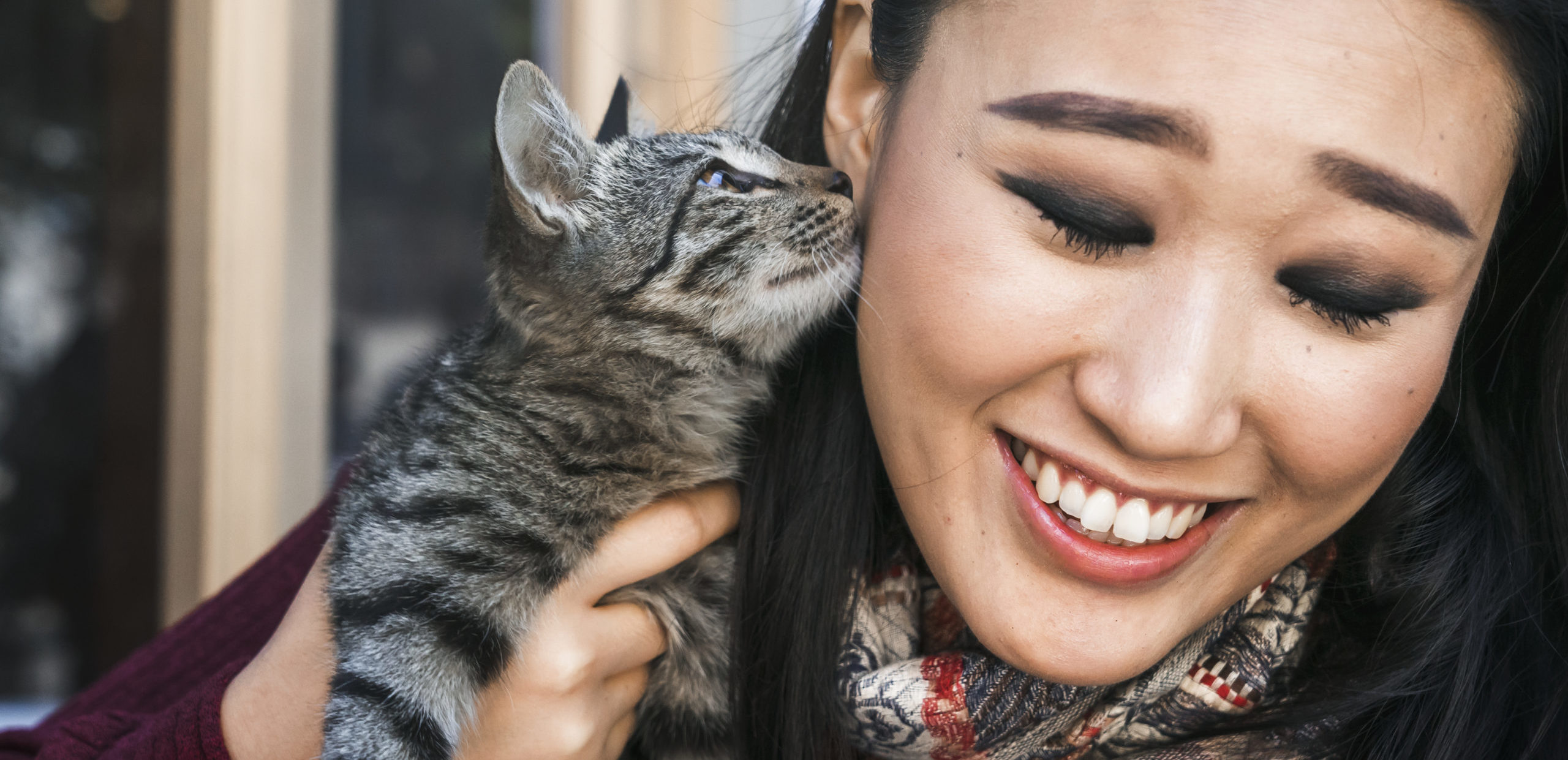You don’t need to be a professional photographer or a renowned writer to be the best person to market your foster cat for adoption. Try not to let the word “marketing” scare you. Promoting your foster cat for adoption is actually pretty simple and fun! You can use this opportunity to dabble in a little creativity (even if you don’t consider yourself the creative or artsy type).
Who knows your foster cat best? YOU!
Using the tips below, anyone can be great at taking photos and videos. Plus, the unique, authentic information you can provide about your foster cat is invaluable. Your participation in marketing your foster cat can help them quickly find the right adopter!
Your goal is to create an emotional connection. Think about the little things that have made YOU connect emotionally with your foster cat and let those things inspire how you market your foster cat for adoption!
Jump to a Topic

Things to Keep in Mind
POSITIVITY.
Keep everything positive! Don’t be afraid to make it silly, fun, and creative. Your marketing content doesn’t need to be perfect. Don’t put that pressure on yourself. Let this be a positive effort and allow good to be good enough!MARKETING VS COUNSELING.
You don’t need to disclose every single annoying quirk and need of your foster cat in the initial marketing info. Those things can be talked about in open conversations, meets, and adoption counseling.CONTACT INFO.
Be sure to include a general location (your city and state) and contact information in all promotion materials.CHANGE IT UP.
Marketing your foster cat for adoption isn’t always one and done. Routinely update marketing material if you're not getting interest. Your latest adorable photo or video could be just what a potential adopter needs to see to say “this is the one for me”!YOU GOT THIS.
Remind yourself that there is someone for everyone! Try not to get discouraged if you’re fostering a cat that has a few quirks or challenges (or if it’s the thick of kitten season).
Is Your Foster Cat Ready for Their Debut?
KITTENS.
In most organizations, kittens are ready for adoption when they are healthy and weigh 2 pounds, which is around 8 weeks old, and after they are spayed or neutered.SPAY/NEUTER.
In most organizations, all cats and kittens need to be spayed or neutered and up-to-date on age appropriate vaccines before they can be adopted. (Some organizations have additional requirements, such as the cat being microchipped.)TIP: Due to the COVID-19 crisis, some spay/neuter services have been temporarily shut down, so you’ll want to talk to your organization about how they are handling spay/neuter for adoption at this time.
ILL OR INJURED.
Has the cat recovered from an illness or injuries and completed treatment? If their symptoms have resolved and the organization’s vet has cleared them for adoption, then you can get started with marketing! And if ongoing treatment will be required for a chronic condition such as diabetes or skin allergies, your marketing creativity will be even more important!BEHAVIOR.
Has the cat been given time to decompress in the foster home, settle in, and show their full personality? If not, give them a little more time so that you have the best idea of what type of home they would thrive in. If a cat has behavior issues that you’re working on, you can still start marketing the cat to someone who is willing and able to continue this work!
The Many Ways to Find Adopters
WORD OF MOUTH.
Start with chatting with your friends, family, co-workers, and acquaintances. Bonus: Once they know that you foster cats, they will likely reach out when they’re ready to adopt!SOCIAL MEDIA.
Share regularly on your own personal social media accounts or create special accounts to market your fosters!ORGANIZATION MARKETING.
The organization you're working with will likely want to promote your foster animal on their own social media platforms and adoption websites like Petfinder.SHARE. SHARE. SHARE.
You can reshare across social media platforms and ask others to do the same!POST LOCAL.
Check in with the organization you are fostering first to see if they have requirements and recommendations for local places to promote your foster cat. We see success with posting in local community resources such as neighborhood websites, newspapers, and neighborhood Facebook pages.MAKE A FUN FLYER!
Hang self-made color flyers in high-traffic, community-oriented places in your neighborhood and the surrounding area!FLYER TIPS
- Free websites like Canva make it easy!
- Make the pictures the focus
- Print in color
- Use short blurbs and bullet points, rather than paragraphs, to describe the cat
- Avoid filling the flyer with text
- Create a happy balance of fonts, text sizes, and colors throughout
- Include the organization's logo
- Don’t forget contact info

Write All About Your Foster Cat
THE GOAL.
You may hear several terms thrown around, but they all refer to gushing all about your foster cat! Whether the organization you are fostering for calls it a bio, a profile, an ad, a write-up, a description, or content, your foster cat will need a descriptive profile to be used to promote them for adoption.AVOID A NOVEL.
Try to be clear, creative, short, and informative. You don’t need to write a book. Adopters may honestly skip it or still reach out based solely on pictures. Use an array of adjectives! Be authentic!TELL A POSITIVE STORY.
A good description tells a story and highlights your foster cat’s best traits. Be positive, honest and avoid using negative language. “Before” and “after” photos can be powerful. The time a foster cat spends with you is invaluable because you can figure out why they may have been getting overlooked at the shelter and focus on the amazing transformation and discoveries while in foster care!HAVE A FEW VERSIONS.
You can write different versions for different platforms….a flyer may need a bullet point list, while the online profile is a bit longer. Remember that each platform may need different styles of text...short one line attention grabbers vs a short paragraph with a link to the full adoption post.AVOID “STOP SIGN” LANGUAGE.
You want to get adopters “in the door” and hooked on the wonderful traits about your foster cat. You can highlight potential obstacles in a positive light, but you don’t need to list every annoying thing your foster cat does, such as jumping on counters. Leave out the caveats and avoid starting with things like, “he’s a shy guy”. Avoid industry language, shelter/vet speak, and STOP sign language about challenges that can be discussed during counseling, not in marketing - things like, “she is not a lap cat” or “she cannot live with kids or other pets”.The most important thing is to make sure that details don’t slip through the cracks and whoever is doing the adoption counseling knows all of your foster cat’s potential challenges, quirks, and needs. They do need to have an open, honest conversation with the potential adopters about these things, if the cat is really the right fit for them, and ways to work through any potential challenges.
EDIT.
Reread everything you write, avoid being repetitive, and double check your grammar and spelling.NOT YOUR CUP OF TEA.
Are you struggling with writing? It’s ok! You can get everything down on paper and then ask the organization you’re fostering for, or a fellow foster, volunteer, or friend, if they can help you spruce it up!STRUCTURE.
There are a few different ways to tackle writing an adoption bio, but the key is to grab a potential adopter’s attention and start positive. Be sure to reread the profile and ask yourself if it would inspire you to adopt.TIPS ON WRITING A BIO
- PERSONALITY. The first part of the profile should be an attention grabbing description of the cat that highlights their personality, energy level, best traits and likes. Be sure to include the things that have created an emotional connection for you. Include their name! You can include their age and color in the initial descriptive language, but you don’t need to list all facts right away.
- NEEDS. Be gentle with restrictions, but include if they are good with cats, dogs and children. In a positive way, include if the cat would prefer to be the only pet, should not live in a home with young children, needs a high-energy playmate, or anything else about the type of home the cat would thrive in. Try not to leave the adopter wondering why you are recommending these things so that it is not a strike against the cat.
- For example, “Jo-Jo’s such a goofy bundle of energy, he might be a little too much for small children!” is worlds better than “Must go to a home with no children,” which leaves the reader raising an eyebrow.
- Another example: “Matilda would make an excellent companion for another calm cat who also believes that lazing about on a window sill is enough excitement for one day!” instead of “Must go to a home with older cats only.”
- SELL IT! Next, include words that encourage the reader to take immediate action to adopt the cat. Make the reader feel they have the ideal environment for that specific cat or kitten. Tug at their heart by painting a picture of the cat in their home. Tell them how lucky the cat would be to have them, how grateful the cat would feel toward the wonderful human being who would give them a home.
- FACTS. Then, you can include a brief list of factual information such as the age, color, and the cat’s organization ID number, overall health of the cat, spayed/neutered status, vaccine and microchip information.
- FINALLY. Include a statement that includes a contact email address and the cat’s organization ID#. If you are a foster parent and are comfortable having adopters reach out to you directly, include a catchy closing line asking the adopter to reach out to you, the cat’s foster parent, at your email address.

Take Great Photos, Even with Your Phone
THE GOAL.
Photos are the most important part of marketing your foster cat. They’re often the first thing that catches an adopter’s attention. You will need several good quality pictures to accompany their adoption profile, for social media, and for flyers. Follow the tips below and you can easily capture amazing photos of your foster cat and discover how One Picture Saves A Life™!BE PREPARED.
Always keep your camera close by at home. You never know when your foster cat is going to strike an adorable pose!PRIMPING.
Take a minute to make sure your foster cat is looking their very best! Add a cute collar or bow-tie if it doesn’t cause them stress.CAMERA SETTINGS.
Become familiar with the settings on your camera. Have you discovered “portrait mode” on your smartphone yet? It works wonderfully for photo shoots with (tired) cats! Skip zooming and instead plan to crop later. Avoid blurry photos by learning the ways to focus the camera.LIGHTING.
Natural lighting is best! Plan to take photos during the daytime. Avoid using the flash, photos of glowing eyes, or directing the camera right at the light source, which will wash-out the photo or cause the cat to look much darker than they are. Adjust the camera settings or angle to brighten up the shot.BACKDROP.
De-clutter the background and consider using a bright backdrop like your foster cat’s favorite chair, blanket, or bed to bring out contrast, especially for dark colored cats and kittens.BE LEVEL.
Hold the camera at the same level as their eyes. Avoid hovering over them or taking a photo of the top of their head.EYE CONTACT.
Try to capture the cat looking straight into the camera. Eye contact is everything! Dangle noisy toys above the camera to help encourage the cat to look at the camera.FILL THE SPACE.
Try to fill the frame with the cat, avoid showing a lot of background especially if it’s busy. It’s good to include photos with a person or another pet (if they’ve met and get along), but focus on the foster cat and allow the rest to enhance the background.BREATHE.
Try to minimize disrupting them if they’re already doing something adorably photo-worthy. Talk calmly in a low voice to get their attention and to help them relax. Be patient and take several photos so that you can pick only the best!BE POSITIVE.
Avoid using photos of the cat looking stressed (or stressing the cat while taking photos). Avoid blurry photos, busy or messy backgrounds, and shots of them walking or feeding.EDIT.
Most cameras and computers have free editing tools to help you quickly crop out busy, unnecessary backgrounds and adjust the brightness, contract, saturation, and other features to make your photo pop! Remember that the focus should be on the cat!
Videos Are Gold!
GOAL.
Try to capture your foster cat’s personality. The goal is to help the adopter envision this cat living in their home. Videos really are an amazing tool to help reach this goal!BE PREPARED.
Always keep your camera close by at home. You never know when your foster cat is going to do something adorable!LIGHTING.
It’s all about natural light! Plan to take videos during the daytime. Avoid using the flash, videos of glowing eyes, or directing the camera right at the light source which will wash-out the video or cause the cat to look much darker than they are. Adjust the camera settings or angle to brighten up the shot.BE LEVEL & STEADY.
Try to keep the camera steady while filming and at the same level as the cat. We don’t want to give adopters motion sickness!FILL THE SPACE.
Try to fill the frame with the cat, avoid showing a lot of background especially if it’s busy or messy. You can video your foster cat with a person or another pet (if they’ve met and get along), but focus on the foster cat, highlighting their traits to show things like how they love to snuggle or how good they are with another cat.BREATHE.
Try to minimize disrupting them if they’re already doing something worth filming. Talk calmly in a low voice to get their attention and to help them relax. Be patient and take a long video that can always be edited or clipped later on.SOUND.
If there’s a lot of background noise, turn the sound off before using the video for marketing. And if the video would benefit from narration, be sure to speak loud and clear!LENGTH.
Aim to keep the video under 1 minute. Or take several short videos under 30 seconds in different settings...one of the cat playing, one of the cat snuggling on the sofa, one of the cat asking for pets, etc.BE POSITIVE.
Avoid using videos of the cat looking stressed (and avoid stressing the cat while videoing). Avoid blurry videos and busy or messy backgrounds.EDIT.
Most cameras and computers have free editing tools, so it’s really easy to cut out bloopers, unnecessary parts, or focus solely on the one adorable moment in the several minutes of video you took.BONUS!
Want to try a fun new way to promote your foster? Many computers come with easy to use video editing tools that allow you to combine multiple videos and photos together, add text, and add music. Give it a try to promote your foster cat! The video can be added to the adoption profile and social media for the organization you’re fostering for, as well as to your own social media platforms!
Up and Running!
Has your marketing material been posted and now adopters are reaching out?
ADOPTION PROCESS.
Some organizations want foster parents to be very involved in finding potential adopters, setting up meet-and-greets, and selecting an adopter; other organizations may have different expectations and rules about the adoption process and who handles each part of it. Ask the organization you’re fostering for about their adoption process and policies to ensure you’re both on the same page about who is doing what in the meet-and-greet and adoption process.GOAL.
The overall goal is to find the first qualified adopter for your foster cat, while informing them about cat care and answering their questions. This recipe will allow adopters to have a good experience adopting while you find an amazing home for your foster cat!BE ACCESSIBLE.
The faster an adopter can chat with someone and meet the cat, the better chance that they’ll stay engaged.ADOPTION COUNSELING.
Some organizations will rely on you, the foster parent, to provide adoption counseling. If you will be doing the counseling, make sure to ask for guidance and resources. And ask the organization questions if you’re not sure about something.Once someone reaches out with interest to adopt your foster cat, and if you are the person who is handling adoption counseling, it’s best to ask all of the hard questions first (for example, if your foster cat is completely terrified of dogs and can’t go to a home with dogs, you’d want to ask if the person up front if they have a dog) so that neither party is wasting their time.
DETAILS.
If the organization provides the adoption counseling, you’ll want to make sure the organization is aware of any and all behavior/medical issues the cat may have. These issues should be mentioned when the person meets the cat, whether in person or virtually, but they also need to be discussed during the counseling process, and organizations may ask the adopter to sign waivers. Ask your organization for guidance on how/when to discuss behavior or medical issues with potential adopters.BE POSITIVE.
When discussing adoption, keep the conversation positive and open-ended, and listen to the adopter! Try to encourage honest answers, be objective, and avoid being judgmental. Understand the importance of not making assumptions or having biases.ALTERNATIVES to NO.
It’s so wonderful that more and more people every year are choosing adoption, rather than pet stores, for finding a new cat to join their family. And positive, conversation-based adoption processes mean that more fabulous adoptions happen every year!Occasionally you might find that a potential adopter might not be a good match for your foster cat. And if you are responsible for selecting an adopter, it’s important to know that a “no” doesn’t have to be a closed door to all adoption but rather can be a window to finding a different kind of cat, or to sharing more information that supports adoption.
- Change “no” to “How about a different cat?” If the conversation leads to, “no, the potential adopter isn’t the right fit for this cat,” you can talk to them about the type of cat that would be a better fit for their home.For example, the potential adopter might have their heart set on a cat who will be super-cuddly, but you know that your foster cat is decidedly more independent and won’t give the adopter what they expect from a cat. You can talk about the wide range of cat personalities and share that while your foster cat might not be perfect for them, there are other cats at the organization that could be. And if their expectations of having a cat don’t quite line up with the reality of being a cat parent, you can share information that will give them a better idea of what it’s like to have a cat and share any resources your organization has to support pet guardians and adoption.
- Turning “no” into “yes.”Talking to potential adopters is also a great chance to share information they may not be familiar with. Sometimes this can change a “no” into a “yes.”For example, many people do not know exactly what is involved in declawing a cat. A potential adopter might have said on their application that they plan to declaw a cat they adopt. Rather than immediately saying “no” to that person, you can look at this as a wonderful opportunity for you to kindly and respectfully share what declawing involves and to talk about the wide array of alternatives to declawing. Your conversation could completely change their mind on declawing so that they could adopt your foster cat, or it could lead them to a different match at your shelter.
If you will be the person handling meet-and-greets and adoption counseling for your foster cat, talk to the organization you’re fostering for about their procedures for when a match isn’t made so you know how to assist with all of the options available to people who are interested in adopting.

Making It Official!
FINALIZING AN ADOPTION.
Each organization does things a little bit differently to finalize an adoption. Check with the organization you’re fostering for about their adoption paperwork and policies to ensure you’re both on the same page if you’re handling the adoption process.STAY IN TOUCH.
You can always offer to pass your contact information along to adopters as a resource if they need help or if you would like updates. You can do your best to express how much updates would mean to you, but remember that some adopters may not be great at staying in touch. Many are so appreciative of the love you gave and time you spent fostering their new family member that they will likely stay in touch sending happy updates and photos!POST-ADOPTION TIPS
- It’s good to follow-up with the adopter in 2 weeks, 1 month, and 6 months. Find out if your organization does follow-ups or if you should do them.
- Be prepared to have additional conversations to help work through any issues that arise.
- If an adopter contacts you and strongly feels the need to return the cat, you can be rightfully disappointed, but try not to be discouraged and do stay calm and respectful with the adopter. Be sure to contact the organization you fostered for and understand the return policy. You should never just take the cat back into your care. If the cat is officially returned to your foster care, try to take the new information you’ve learned from the adoption to help you find a better fit for your foster cat in the future!



